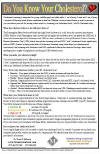Know your complete cholesterol profile in 5 minutes
Cholesterol is a soft, waxy substance found among the lipids (fats) in the bloodstream and in all your body’s cells. It is normal to have cholesterol. It’s an important part of a healthy body because it’s used to form cell membranes, some hormones and other needed tissues. But too high a level of cholesterol in the blood is a major risk for coronary heart disease, which leads to heart attack. It’s also a risk factor for stroke. Hypercholesterolemia is the term for high levels of blood cholesterol.

You get cholesterol in two ways. Your body makes some of it, and the rest comes from animal products that you eat, such as meats, poultry, fish, eggs, butter, cheese and whole milk. Food from plants like fruits, vegetables and cereals do not have cholesterol.
Cholesterol and other fats can’t dissolve in the blood. They have to be transported to and from the cells by special carriers called lipoproteins. There are two kinds that you need to be concerned with. Low-density lipoprotein, or LDL, is known as the “bad” cholesterol. Too much LDL cholesterol can clog the arteries to your heart and increase your risk of heart attack. High-density lipoprotein, or HDL, is known as the “good” cholesterol. Your body makes HDL cholesterol for your protection. It travels away from your arteries. Studies suggest that high levels of HDL cholesterol reduce your risk of heart attack.
What’s the Difference Between LDL and HDL Cholesterol?
Why is LDL cholesterol considered “bad”?A high level (more than 160 mg/dL or higher than 130 mg/dL if you have two or more risk factors for cardiovascular disease) of low-density lipoprotein, or LDL cholesterol, reflects an increased risk of heart disease. That’s why LDL cholesterol is often called “bad” cholesterol. Lower levels of LDL cholesterol reflect a lower risk of heart disease. When too much LDL cholesterol circulates in the blood, it can slowly build up in the walls of the arteries that feed the heart and brain. Together with other substances it can form plaque, a thick, hard deposit that can clog those arteries. This condition is known as atherosclerosis. If a clot (thrombus) forms where a plaque is, the blood flow can be blocked to part of the heart muscle, causing a heart attack. If a clot blocks blood flow to part of the brain, a stroke results. The levels of HDL cholesterol and LDL cholesterol in the blood are measured to evaluate the risk of having a heart attack.
What is Lp(a) cholesterol?
Lp(a) is a genetic variation of plasma LDL. A high level of Lp(a) is an important risk factor for developing atherosclerosis prematurely. The way an increased Lp(a) contributes to disease isn’t understood. The lesions in artery walls contain substances that may interact with Lp(a), leading to the buildup of lipids in atherosclerotic plaques.
Why is HDL cholesterol considered “good”?
About one-third to one-fourth of blood cholesterol is carried by high-density lipoprotein (HDL). HDL cholesterol is known as the “good” cholesterol because a high level of HDL cholesterol seems to protect against heart attack. Medical experts think that HDL tends to carry cholesterol away from the arteries and back to the liver, where it is passed from the body. Some experts believe that excess cholesterol is removed from atherosclerotic plaque by HDL, thus slowing the build-up. However, low HDL cholesterol levels (lower than 40 mg/dL) may result in a greater risk for heart disease.
What is triglyceride?
Triglyceride is a form of fat. It comes from food and is also made in your body. People with high triglycerides often have a high total cholesterol, a high LDL cholesterol and a low HDL cholesterol level. Many people with heart disease also have high triglyceride levels. Several clinical studies have shown that people with above-normal triglyceride levels (greater than or equal to 200 mg/dL) have an increased risk of heart disease. Doctors need to treat high triglycerides in people who also have high LDL cholesterol levels. People with diabetes or who are obese are also likely to have high triglycerides.
What are healthy levels of cholesterol?
Your total blood cholesterol level
Your total blood cholesterol will fall into one of these categories:
Desirable — Less than 200 mg/dL
Borderline high risk — 200-239 mg/dL
High risk — 240 mg/dL and over
Desirable
If your total cholesterol is less than 200 mg/dL, your heart attack risk is relatively low, unless you have other risk factors. Even with a low risk, it’s still smart to eat foods low in saturated fat and cholesterol, as well as get plenty of physical activity. Have your cholesterol levels measured every five years or more often if you?re a man over 45 or a woman over 55.
Borderline high risk
In general, people who have a total cholesterol level of 240 mg/dL have twice the risk of heart attack as people who have a cholesterol level of 200 mg/dL. About a third of American adults are in the borderline group, while almost half of adults have total cholesterol levels below 200 mg/dL. Have your cholesterol and HDL rechecked in one to two years if:
- Your total cholesterol is in this range
- Your HDL is less than 40 mg/dL
- You don’t have other risk factors for heart disease
You should also lower your intake of foods high in saturated fat and cholesterol to reduce your cholesterol level to below 200. Your doctor may order another blood test to measure your LDL cholesterol. Ask your doctor to discuss your LDL cholesterol with you. Even if your cholesterol is between 200 and 239 mg/dL, you may not be at high risk for a heart attack. Some people, such as women before menopause, and young, active men who have no other risk factors, may have high HDL cholesterol and desirable LDL levels. Ask your doctor to interpret your results. Everyone’s case is different.
High risk
If your total cholesterol level is 240 or more, it’s definitely high. Your risk of heart attack and, indirectly, of stroke is greater. You need more tests. Ask your doctor for advice. About 20 percent of the U.S. population has high blood cholesterol levels.
Your LDL cholesterol level
Your LDL cholesterol level greatly affects your risk of heart attack and, indirectly, of stroke. The lower your LDL cholesterol, the lower your risk. In fact, it’s a better gauge of risk than total blood cholesterol. Your LDL cholesterol will fall into one of these categories:
Desirable — less than 130 mg/dL
Borderline high risk — 130-159 mg/dL
High risk — 160 mg/dL or higher
The key point to remember is, the lower your LDL cholesterol, the lower your risk. Your doctor may prescribe a diet low in saturated fat and cholesterol, regular exercise and a weight management program if you’re overweight. If you can’t lower your cholesterol with these efforts, medications may also be prescribed to lower your LDL cholesterol. Check these categories and the goals for treatment that can lower your risk of heart attack.
|
*In men less than 35 years of age and premenopausal women with LDL cholesterol levels of 190 to 219 mg/dL, drug therapy should be delayed except in high-risk patients such as those with diabetes.
**In coronary heart disease patients with LDL cholesterol levels of 100 to 129 mg/dL, the doctor should consider whether to initiate drug treatment in addition to the American Heart Association Step 2 Diet.
If you do not know if you have other risk factors for heart disease, check out the American Heart Association’s list by clicking here.
Your HDL cholesterol level
In the average man, HDL cholesterol levels range from 40 to 50 mg/dL. In the average woman, they range from 50 to 60 mg/dL. HDL cholesterol that’;s less than 40 mg/dL is low. Low HDL cholesterol puts you at high risk for heart disease. Smoking, being overweight and being sedentary can all result in lower HDL cholesterol. If you have low HDL cholesterol, you can help raise it by:
- Not smoking
- Losing weight (or maintaining a healthy weight)
- Being physically active for at least 30-60 minutes a day on most days of the week.
People with high blood triglycerides usually have lower HDL cholesterol and a higher risk of heart attack and, indirectly, of stroke. Progesterone, anabolic steroids and male sex hormones (testosterone) also lower HDL cholesterol levels. Female sex hormones raise HDL cholesterol levels.
Cholesterol ratio
The American Heart Association recommends that the absolute numbers for total blood cholesterol and HDL cholesterol levels be used. They are more useful to the physician than the cholesterol ratio in determining the appropriate treatment for patients.
Total blood cholesterol is the most common measurement of blood cholesterol. It is the number you normally receive as test results. Cholesterol is measured in milligrams per deciliter of blood (mg/dL). Knowing your total blood cholesterol level is an important first step in determining your risk for heart disease. However, a critical second step is knowing your HDL or “good” cholesterol level.
Some physicians and cholesterol technicians use the ratio of total cholesterol to HDL cholesterol in place of the total blood cholesterol.
The ratio is obtained by dividing the HDL cholesterol level into the total cholesterol. For example, if a person has a total cholesterol of 200 mg/dL and an HDL cholesterol level of 50 mg/dL, the ratio would be stated as 4:1. The goal is to keep the ratio below 5:1; the optimum ratio is 3.5:1.
Your triglyceride level
Your triglyceride level will fall into one of these categories:
| Triglyceride Level | Classification |
| Less than 150 mg/dL 150-199 mg/dL 200-499 mg/dL 500 mg/dL or higher | Normal Borderline-high High Very high |
any people with high triglycerides have underlying diseases or genetic disorders. If this applies to you, the main therapy is to change your lifestyle. This includes controlling your weight, eating foods low in saturated fat and cholesterol, exercising regularly, not smoking and, in some cases, drinking less alcohol. People with high triglycerides may also need to limit their intake of carbohydrates to no more than 45–50 percent of total calories. The reason for this is that carbohydrates raise triglycerides and lower HDL cholesterol. Use products with monounsaturated and polyunsaturated fats.
Special Message for Women
As a rule, women have higher HDL cholesterol levels than men. The female sex hormone estrogen tends to raise HDL cholesterol, which may help explain why premenopausal women are usually protected from developing heart disease. Estrogen production is highest during the childbearing years. Women also tend to have higher triglyceride levels. Triglyceride levels range from about 50 to 250 mg/dL, depending on age and sex. As people get older, more overweight or both, their triglyceride and cholesterol levels tend to rise.

Hormone replacement therapy (HRT) may benefit some women with osteoporosis or other medical conditions associated with menopause. Women with a personal or family history of breast cancer or other endocrine-related cancers should not receive HRT. The HERS trial in women who had previously had a heart attack showed that these women did not benefit from HRT. Recent clinical trials appear to confirm that HRT does not appear to reduce risk of cardiovascular disease and stroke in post menopausal women.
The American Heart Association recommends the use of statins as the first line of drug therapy for women with heart disease. This should be combined with a low-fat, low-cholesterol diet, weight management and regular exercise. Statin drugs are very effective for lowering LDL cholesterol levels and have few immediate short-term side effects. They work by interrupting the formation of cholesterol from the circulating blood.
